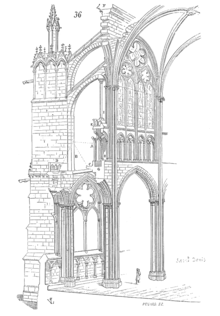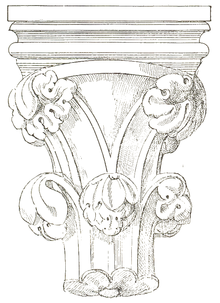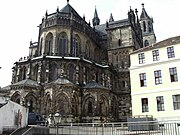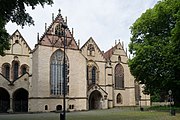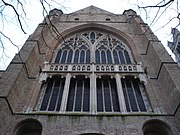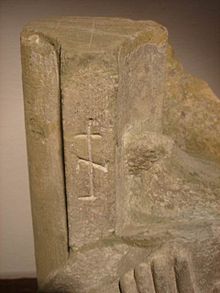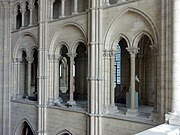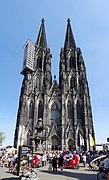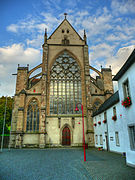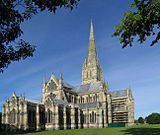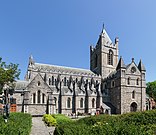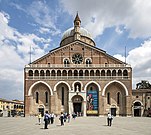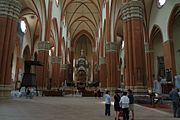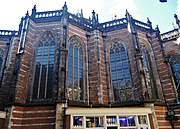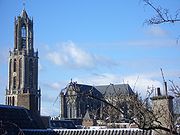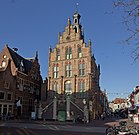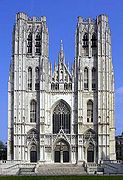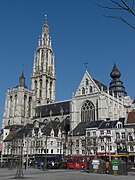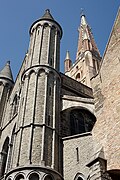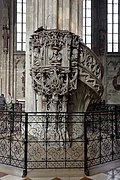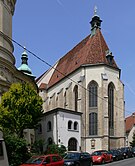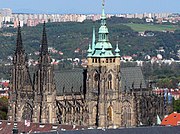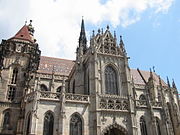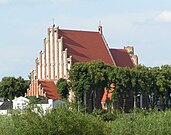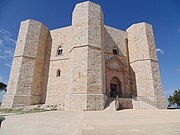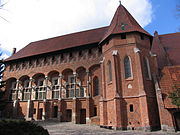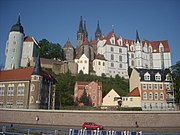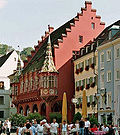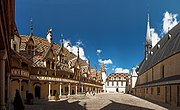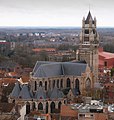Gothic
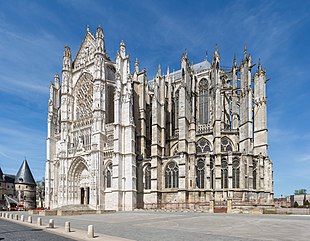
The Gothic designates an epoch of European architecture and art of the Middle Ages , which in its various national forms of early , high and late Gothic extends from around the middle of the 12th century to around 1500. The previously predominant architectural and art style is known as Romanesque , the subsequent one as Renaissance .
Initially used by Giorgio Vasari as a derogatory description of architecture, the term gradually established itself in the course of the 19th century for painting and sculpture that were created at the same time . Gothic architecture originated in Île-de-France ( Paris and the surrounding area) around 1140 and lasted north of the Alps into the first half of the 16th century. The Gothic style can only be precisely delimited in architecture, while this is not possible with the same degree of clarity in the areas of sculpture and painting . The Gothic cathedral is an outstanding work of artwhich combines architecture, sculpture and ( glass ) painting of the Middle Ages as a total work of art . It stands at the beginning of a new design of the church interior, which appears through the first combination of Burgundian ( pointed arch ) and Norman formal elements ( ribbed vaults ) and the further development of innovative building measures. In addition, secular architecture, especially in the urban environment, experienced its first heyday: in addition to aristocratic residences, town halls and town houses, which are rarely preserved in their original state, are important building projects.
In architecture, a distinction is made between the phases of early, high and late Gothic , which were adopted in the various European art landscapes at different times and then in some cases developed independently of one another. In England they speak of the Early English Style , the Decorated Style and the Perpendicular Style . In France, a distinction is made between the early Gothic Gothique primitif (1130–1180), the mature Gothique classique (1180–1230), then the refined Gothique rayonnant , followed by the late Gothic style flamboyant . The brick Gothic can be found not only in northern Germany .
In the Nachgotik the Gothic style continued to live beyond its era and is as Baroque-Gothic style as a mix between Baroque even detectable and Gothic in the Baroque period. In the 19th century, the neo-Gothic architectural style found new interest as a variant of historicism .
Development of the style name

The style developed in France and the new construction technology were called opus francigenum around 1280 . Even in the 20th century, the term is found in the literature again French style or French style . Since the pointed arch is considered a central element of Gothic architecture, the style was originally called the pointed arch style . The current name Gothic (from Italian gotico “strange, barbaric”, originally a swear word, derived from the name of the Germanic tribe of the Goths ) was coined in the Renaissance by the Italian art theorist Giorgio Vasari , who thereby expressed his disdain for Gothic art towards the golden age of the ancient world . Even if Vasari's assessment is no longer shared today, this designation was adopted, gradually became established and later lost its negative connotation. The name of the Gothic as maniera tedesca (German manner), which was customary in the Renaissance, is said to come from Vasari.
In Germany a new enthusiasm for the Gothic began with Goethe's text “ Von Deutscher Baukunst ”, printed in 1773 , which declared it to be the German style . The misunderstanding that the Gothic originated in Germany could not be cleared up until the middle to the end of the 19th century through research in art history. In Germany, as in many other countries, the Gothic was regarded as a national style in the 19th century, which among other things led to a positive re-evaluation of medieval art, which had been despised up to that time.
architecture
Historical foundations in the 12th and 13th centuries

The 12th and 13th centuries were marked by a spiritual, theological, political, economic and technical awakening. The demands on church construction therefore changed:
- As in the Romanesque , church buildings were demonstrations of the power of the rulers and the clergy . In addition to the power of the king and the bishops grew up in France , the influence of the 12th century religious orders such. B. the Cistercians . In addition, various large lay movements such as B. on the Cathars as competition to the official church . But the strengthening of the cities also led to “buildings of power” in the center of the city. In this competitive situation the king, the monarchically oriented nobility, cathedral chapters, bishops and cities tried to outdo each other with ever more magnificent buildings - as a demonstration of their leadership, but also out of genuine pious enthusiasm.
- At the beginning of the epoch a phase of general restructuring began in the country's economic life. The economy developed positively in certain regions and in the cities. The focus of trade shifted from the countryside to the city. The rural population streamed into the cities ( rural exodus ). In France, the economic basis was the strengthening of the French kingship in the 12th century at the expense of the lower nobility and the economic strengthening of the flourishing city towns promoted by the kings. The cities in particular developed the strength to finance and realize the lavish Gothic buildings. As the cities grew, there was also a need for new church buildings.
- Gothic architecture was able to fall back on the foundations of technically developed architecture and the craftsmanship of the Romanesque. Ribbed vaults , pointed arches and buttresses had already been successfully introduced in the Romanesque period, and Romanesque buildings were increasingly taller and more exposed. The further development of construction metallurgy created the prerequisites for being able to build the increasingly demanding and complex Gothic architecture, even on very large scales.
- In theological terms, churches were seen as an integral part of the liturgy . They pointed to the New Jerusalem . The cathedral of Saint-Denis was to become the new temple of Solomon after Abbot Suger of Saint-Denis . Durandus von Mende († 1296) wrote: "Everything that belongs to church services, things and decorations (ornamenta) is full of divine signs and secrets." The church buildings, like the cosmos, should become a perfect unit: beautiful, harmonious and clear through light, geometry, proportions, material and color. In the Romanesque era there were relatively small window openings and large wall surfaces. In the Gothic period, the wall surfaces were increasingly dismantled and largely replaced by glass windows , which from the inside looked like translucent "glass walls" and became an essential design element of the church architecture. The rays of the sun, the light of God, should encompass the whole church and transform the building into a built metaphysics . In France, this light architecture developed from Saint-Denis (from 1130/35) to the Cathedral of Chartres (1194–1260) and the Sainte-Chapelle (1244–1248) in Paris.
Origin of the style
From Romanesque to Gothic
The Gothic style developed out of the Romanesque style in the Middle Ages . Many individual elements of the Gothic system can already be found in the Romanesque, especially in Normandy , in the French crown lands of the Île-de-France , in Burgundy and in Norman Sicily . The ambulatory existed in the Romanesque as early as the 11th century; it was further developed in the Gothic with a walkway and chapel wreath to form a coherent system of supports and vaults. The first double-towered west facades were built around the same time in Normandy and Burgundy. But only when the construction of the Gothic ribbed vault with load-bearing ribs was successful, a new building system was able to develop that made it possible to cut vaults over various floor plans and to break through the wall. The Gothic did not create any fundamentally new building types. In the course of its development, however, the Gothic building was increasingly understood as a unit in which each individual part depends on the whole. So the Gothic developed its own architectural system as well as a number of new architectural elements. However, not all elements of Gothic basilicas were adopted in large hall churches of all phases of Gothic. Even more fashionable style elements were used in village churches and secular buildings, but not the whole system of perfect pioneering buildings.
Norman forerunners

A number of Norman basilicas, which were donated by William the Conqueror or who appointed clerical dignitaries as builders, can be regarded as the most important step towards the Gothic, pointed arched ribbed vault . These include the Abbey Church of Lessay , the men's abbey of Saint-Étienne and the women's abbey of Sainte-Trinité in Caen (both donated around 1060) and the Durham Cathedral in northern England. All have Romanesque portals and windows. In all of them, at least the central nave has ribbed vaults and two-layer top wall masonry. In the continental churches these rib vaults are round arched. In Durham alone, built from 1093 onwards, the vaults are pointed arches. The first pointed arched vaults previously existed in individual chapels of small Norman churches in England, but it took decades for vaults to replace the wooden ceilings of the central aisles in other English cathedrals.
The first pointed arch windows and pointed arch portals of Christian buildings were erected at the same time in another area of Europe, but also under Norman rule. From 1071, they are works of Norman-Arabic-Byzantine architecture in the Norman-ruled southern Italy
Late Burgundian Romanesque
In Burgundy, starting with the third basilica of the Benedictine Abbey of Cluny, which was built in 1088 , a number of sophisticated basilicas with Romanesque facades, but pointed vaults and arcade arches , arose . The pointed barrels of the central aisles and transept arms and the pointed groin vaults of the side aisles had no ribs.
When the construction of Cluny III began, most of the Arab-Norman architecture had not yet been built, but there was still Arab architecture in Sicily , which over time was rebuilt under the builders' authority or government of the Normans (for example, in Palermo, the emir's summer palace became the Norman royal castle ) or has been replaced. Since the Latin monastic orders wanted to regain a foothold in Sicily, which was then dominated by Orthodox monasteries, monks traveled to Sicily (and back again). Such was Ansgerius , the founding bishop of the Latin Diocese of Catania , a 1091 Called to Sicily Benedictine from Normandy.
The abbey church "Cluny III" was provided with buttresses until 1130, ten years before the construction of the abbey church Saint-Denis , after the first central nave collapsed here.
The beginnings in France
The former abbey church of Saint-Denis in Paris is generally considered to be the first Gothic church building . The abbey , directly subordinate to the king, was the burial place of the French royal family and already held a special position in the Romanesque period. Under Abbot Suger , the west building with a double tower facade was erected in 1137–1140 , and from 1140 onwards the ambulatory choir with a chapel wreath, buttresses and cross-ribbed vaults, which was lit with large windows and which combined all the architectural elements into a single space. With the simultaneous construction of the Cathedral of Sens (from 1140) a rapid development of the early Gothic begins. Examples include the gallery basilicas of the cathedrals of Senlis (from 1153), Laon (from 1155) and Noyon (from approx. 1157) and, as a highlight, Notre Dame de Paris (from 1163). The recipe for success for the development of the style was that each large building brought together what had been achieved before it and at the same time became the basis for subsequent buildings.
According to another approach, the early Gothic is only rated as a preliminary stage and allows the “real” Gothic to begin with the High Gothic at the end of the 12th century. High Gothic begins with the three “classical” cathedrals of Chartres (from 1194), Reims (from 1211) and Amiens (from 1218) as a three- aisled basilica with an ambulatory choir, three-storey wall elevation, tracery windows and a double tower facade.
Cathedral (formerly abbey church) Saint-Denis , before 1140 (modified in the 18th and 19th centuries)
Notre-Dame de Chartres , facade, portals around 1150, rose and left tower from 1194
Notre-Dame de Chartres , north portal
Double tower facade of Notre-Dame de Paris , 1190–1250
High Gothic facade of Amiens Cathedral , portals 1220–1230, rose window and towers 1375–1402
Development outside of France
Outside France, Gothic architecture was first adopted in England, which began as the actual English Gothic ( Early English ) with the construction of Wells Cathedral in 1180. Again and again, Gothic forms of construction were exported to neighboring French countries through the founding of monasteries by the Cistercians , before the Gothic became generally accepted there.
In the Roman-German Empire , Romanesque initially remained the predominant style. However, the Limburg Cathedral, built in the 11th century, was modernized after 1180 based on the example of the French early Gothic, the interior was based on the cathedral of Laon . The Lilienfeld (Cistercian, from 1202) and the Magdeburg Cathedral (from 1209) show that the new French style was sought, but still had to feel into it. The Capella Speciosa in Klosterneuburg (1222) can no longer be examined because it was removed in 1799. From 1224 onwards, the Bremen Cathedral was vaulted and redesigned in Gothic style without removing the Romanesque arcades. The Church of Our Lady in Trier and the Abbey Church of St. Mauritius in Tholey from around 1230 were built as new Gothic buildings . Today's construction of the Paderborn Cathedral began as a Romanesque basilica in 1210, but was continued by other builders as a Gothic hall church from 1231 after the completion of the first two bays. From the start, as a Gothic hall church, the Elisabethkirche was built in Marburg from 1235 . With the Cologne Cathedral , begun in 1248 , Germany found a connection to the French High Gothic. Six years later, the same style began with the Utrecht Cathedral . In the Netherlands this Gothic stone was not without competition. At the same time, brick Gothic also spread here . There is even visible brick on the tower of the Utrecht Cathedral.
In Flanders, the transition style is called Scheldt Gothic . Later on, the magnificent Brabant Gothic style spread northwards here. The brick Gothic of Flanders did not have an early Roman Gothic phase. Finally, the Kempic Gothic combined brick building with the stonemason culture of the Brabant Gothic.
The spread of Gothic building forms in church building in Italy, where many features of the French cathedral Gothic were dispensed with, goes back to mendicant orders such as the Franciscans and Dominicans . The secular architecture of Italy made extensive use of Gothic forms, for example at the Palazzo Pubblico in Siena .
In Spain, experts from northern France were brought in to introduce the Gothic. This is why a number of Gothic churches in Spain come closer to the architecture of the French crown land than buildings in southern France, where the more angular Gothique méridional developed. In addition, in Aragón and Old Castile, Muslim craftsmen combined ideas from the Gothic with oriental traditions for the Gotico-Mudéjar style .
Significant cuts in the French cathedral Gothic program can be found in all regions of Europe, including France itself, in rural and small-town churches.
Structure
From the Romanesque to the Gothic basilica
The Gothic did not create a fundamentally new building typology, but developed the previous forms into its own architectural system.
The original form of the Romanesque church building was based on the Roman secular building of the basilica . The elements atrium , vestibule, westwork and tower or side towers, nave with or without aisles , transept, main apse , possibly side apses and choir (rarely with ambulatory) as well as double choirs in the east and west added up to a complex spatial structure; one speaks of the additive principle in Romanesque.
In the Gothic period, vestibules are rarely built; the Romanesque elements atrium and west choir are completely omitted. Westworks in their original form are no longer built, but Gothic two-tower facades can either reveal a view of the roof ridge of the nave, as in the cathedral of Reims and the Marienkirche (Lübeck) , or they can form high cross bars, as in the Strasbourg cathedral and the Magdeburg Cathedral . A compromise can be found at Notre-Dame de Paris , where a tracery arcade between the top two tower floors provides a view of the roof ridge.
Gothic churches usually only have a choir in the east. But this can be very large. While Romanesque choirs are rarely more than one or two bays long, Gothic ones are in some places longer than the nave. While in Romanesque churches the choir usually ends with a gable, which is followed by a semicircular apse, which can be significantly lower, Gothic choirs often end in a polygon , around which an ambulatory can be led. In England and parts of northern Germany, however, rectangular choir closings predominate, in Gothic times without an apse. In quite a few churches originally built in the Romanesque style, the apse was removed in the Gothic period. Individual Gothic cross basilicas have a Greek cross as a floor plan. There the very large and long transept can also have a choir.
Layout
As in the Romanesque period, the most common floor plan was the simple long building with a transept . The early Gothic churches still follow the bound system in which a square central nave yoke with six-part vault is assigned two yokes in each of the side aisles. The three-aisled cathedral of Sens (1140–1160) with a simple ambulatory without side chapels stood as a transeptless Gothic church . As directional buildings z. B. the cathedral of Senlis (from 1153) as a three-storey, three-nave gallery basilica . The cross-shaped cathedral of Laon (from 1155), on the other hand, has a broad transept and, as a special feature, a rectangular choir floor plan according to English tradition. Special high-ranking buildings were emphasized by a five-aisled floor plan, such as the early Gothic gallery basilica of the Notre-Dame de Paris cathedral (from 1163) or the high Gothic basilica of Bourges (from around 1195).
In the High Gothic period, the bound system was abandoned in favor of transverse rectangular central nave bays. The pattern for the "classic" French cathedral, the basilica with a three-aisled nave and sweeping transept, double tower facade and ambulatory with chapel wreath, was provided by the high Gothic buildings of Chartres (from 1194), Reims (from 1211) and Amiens (from 1218). In the course of the development of ever more complicated vault shapes, especially in hall churches, the rhythmic yokes fade into the background, the central and side aisles, crossing and choir can merge into a single-looking space.
Ground plan of the Cathedral of Sens Early Gothic three-aisled basilica (from 1140/45) with a later added transept
Bound system of the early Gothic cathedral of Laon (1155–1235)
Floor plan of the high Gothic cathedral of Chartres with transverse rectangular central nave vaults (from 1194)
Floor plan of the Freiburg Minster with a high Gothic nave and a late Gothic choir
Floor plan of Canterbury Cathedral with an early Gothic choir and a late Gothic west nave
Development of the choir area

The Gothic architecture brought considerable changes in the choir area. The ambulatory with a chapel wreath made up of attached chapels, which was already known in the Romanesque period , was combined by the Gothic style with the rib vaulting to form a unified space, in which the chapels can largely merge with the handling in the course of development. Compared to the relatively small choir areas of Romanesque churches, the Gothic choir area is considerably expanded in length and width, which can also have multiple aisles and double passageways. In some cases, the row of chapels is also continued along the long choir, which enabled the installation of a large number of altars. At the same time, the expanded choirs offered space for the installation of large choir stalls for a large number of canons .
The crypts , which were still often built in the Romanesque era , through which the floor of the choir was considerably higher, are generally not used in Gothic churches. The only slightly raised choir was often separated from the lay room by rood screens. As a new element in the 13th century , the pulpit from the preaching churches of the mendicant orders found its way into the church. Another creation of the Gothic is the sacrament house as a small architecture.
The towers

The church towers should proclaim the power of their builders. In the Gothic, this claim was raised to the limits of what was technically possible: higher, lighter and more organic, as part of the overall building. Many of the world's tallest church towers come from the Gothic period or from later completion of Gothic buildings.
The type of multi-towered basilica still comes from the Romanesque (e.g. Bamberg , Naumburg , Limburg ), but was discontinued in the early Gothic period, e.g. B. at the three-aisled cathedral of Laon with its five towers. Originally seven towers were planned here: two west towers, two each on the transept facades and a crossing tower . The Reims cathedral should get seven towers, but only three have been realized. In Chartres even nine towers were planned, but were not implemented.
The double tower facade is the downright “classic” type of construction of the French Gothic cathedral (bishop's church), which could also be used for important collegiate or abbey churches. The facade with the towers should fit organically into the entire Gothic building, and so the two towers stand in front of or above the side aisles; in between lies the central nave. The often richly decorated facades could also be equipped with large portal systems and in some cases with very extensive sculpture cycles. Double tower facades have z. B. the cathedrals of Paris , Reims and Amiens or the Elisabeth Church in Marburg . The English cathedral of Wells offers a variant with towers standing to the side of the aisles . In the Middle Ages, Gothic double-tower facades were often left unfinished, were given different towers as in Chartres and Bourges, or the single tower remained as in Strasbourg . A number of buildings could not be completed until the 19th century, such as the Cologne Cathedral , which with its huge double tower facade is the third highest church building in the world.
Gothic parish churches usually had only one main tower or a single- tower facade , which, however, in the German and Dutch-Flemish Gothic - supported by the up-and-coming bourgeoisie of the cities - could in some cases compete with the dimensions of the largest cathedrals (bishop's churches). An architecturally outstanding example is the Freiburg Minster , whose 116 meter high west tower dominates the facade. After this tower was completed, a competition between the cities began. Individual towers were built in Landshut , Frankfurt am Main , Hamburg or Delft , for example . The Ulm Minster Tower , the tallest church tower in the world at 161.53 meters, was not completed until the 19th century, like quite a few Gothic church towers in Central Europe. A special case is the 136.67 meter high south tower (1359–1433) of St. Stephen's Cathedral in Vienna , which was built as a choir flank tower on the side of the nave. Its position is not that rare in southern Central Europe: the cathedral in Donauwörth has a flank tower, as do many parish churches south of the Danube. In Italy, western towers have always been the exception. An example of a western tower completed in the Middle Ages in the middle of the nave of a cathedral is the Utrecht Cathedral . There, however, the nave collapsed in a hurricane in 1674 and was not rebuilt.
Single towers as a crossing tower can be found e.g. B. at the cathedrals of Salisbury and Beauvais , whose almost 150 m high late Gothic crossing tower collapsed after 4 years.
Construction and style
general characteristics

Above the side aisles, the buttress arches lying one above the other. The buttresses stand next to the aisles, integrated into the outer walls.
A central feature of Gothic architecture is that the outer wall surfaces are largely broken up by windows and that wall thicknesses and vaults are reduced to a minimum. In order to achieve this, the construction elements such as rib vaults , pointed arches and buttresses , which were already known in the Romanesque era , were consistently further developed into a new system in which design and structural issues were combined. The Gothic structural system developed the principle of ancient architecture of support and load considerably.
The decisive innovation of the Gothic construction consisted in relocating the load-bearing elements of the construction largely to the exterior, so that the walls could be largely relieved and broken through to the interior, which could now be filled with glass windows and the entire interior was light and seemingly weightless made appear. At the same time, the lighter Gothic construction made it possible to erect ever taller buildings.
An important technical innovation from the 13th century onwards is the use of tie rods and ring anchors made of iron, which can serve to stiffen and stabilize the statics of parts of buildings and the entire building structure. For the increasingly larger tracery of the windows, iron bars are also becoming an integral part of the window construction.
basilica
The principle of a static equilibrium is established in the basilica design in that the lateral thrust forces of the vaults are diverted to buttresses on the outside of the building and compensated for by applied pressure forces . In the three-aisled basilica, a lower aisle yoke is assigned to each side of a central nave yoke . A pointed arched cross-ribbed vault rests above the central nave yoke , the diagonal ribs of which are supported by the central nave pillars, which absorb the downward thrust of the vault. The outwardly acting vault thrust is directed over the buttresses formed from buttresses over the aisle vaults to buttresses, which absorb the lateral thrust. The stability of the buttresses can be increased by loads made of masonry, which counteract the thrust due to their mass.
Another possibility of absorbing or reducing the vault thrust acting on the outside of the building is to attach tie rods or tie bars under the vault foot from one wall side to the other, which is particularly common in hall churches , as there are no buttresses here.
On the walls of the upper aisle and aisle, the vault stretched between the pillars of a yoke is caught by a pointed arch that serves as a relief arch. This allows the side wall between the supporting skeleton of the pillars to be completely broken through and filled with windows. A high point of this development was reached in the High Gothic period, when large tracery windows took up almost the entire wall surface of the upper aisle and the rear wall of the triforium below was also broken through with windows. For the first time, a transparent triforium can be found around 1231 at the cathedral of Saint-Denis .
Hall churches
The hall church represents a special form of the Gothic church structure. In contrast to the basilica, all side aisles here have the same height, so that the nave resembles a huge hall. The model for this was not provided by the Île-de-France , but by the Angevin Empire, which existed in western and northern France from 1128 to 1204, where hall churches in the Romanesque style had previously been built in Poitou , with barrel vaults . Now, as an alternative to the pointed ribbed vault, the domical vault was developed as an equally pointed ribbed vault. In the cathedral of Poitiers and some other buildings, halls were built from naves of equal height with domical vaults, which corresponded to the aesthetics of the emerging Gothic. Probably through the exile there of Heinrich the Lion and Bernhard zur Lippe , it became a model for the construction of hall churches in Germany.
Strictly speaking, Poitiers Cathedral is a staggered hall , with its central nave slightly higher than the aisles. Between the cross-section of the relay hall and the basilica is that of the pseudo-basilica , here the fighters of the central nave vaults are on or above the apex of the aisle vaults. Conversely, in Spain basilicas were created with the cross-section of relay halls, with small windows in the central nave over the apex of the slightly lower aisle vaults. The shape of the individual vaulted yokes and the question of basilica or hall church were not permanently linked: In the German late Romanesque period , several basilicas with domical vaults, but still Romanesque windows and portals, and many, if not most of the Gothic hall churches, received groin vaults.
Hall churches get by with significantly fewer external struts than basilicas, and even without them if they are stabilized by a line of chapels. And naves of the same height enabled innovative vault constructions, from the choir polygon of the two-aisled Jacobin Church in Toulouse (1230) to the dissolution of the yoke boundaries in the St. Anne's Church in Annaberg-Buchholz (1499–1525), supported by a central column ("Palmier" ) .
The hall church type was particularly popular in Germany, but it also occurs in other countries. Probably the tallest aisle built in the Middle Ages is that of the Munich Frauenkirche at 37 m. The vaults of the Jacobin Church in Toulouse and the St. Mary's Church in Gdańsk are 29 meters high . In particular, however, not only parish churches were often realized as halls or relay halls. Pseudo-basilicas were sometimes created through the expansion of single-nave churches or through simplification.
Romanesque basilicas were often subsequently converted into Gothic hall churches. Two-aisled hall churches were built regionally, especially in Austria , and especially as religious churches . One of the largest is the Franciscan / Jacobin church in Toulouse (choir completed around 1290, nave around 1330).
Double aisles are usually not included in the halls. The Notre-Dame de Paris Cathedral and the Cologne Cathedral are five aisles full-length. The double ambulatory of the Cathedral of Reims had room for the coronation of French kings. The double aisles of the Augsburg Cathedral were built as part of the expansion of the originally Romanesque nave. In the Ulm Minster , which was planned to have three aisles , an impending collapse was averted by dividing the aisles lengthways. Among the five-aisled Gothic basilicas of the Milan Cathedral alone, the outer aisles are lower than the inner ones.
Poitiers Cathedral , from 1166, is considered a model for German hall churches
St. Maria zur Wiese in Soest, before 1421, pillars without combatants
Central nave of St. Stephen's Cathedral in Vienna , 1st half of the 15th century
Reims Cathedral : double ambulatory, no hall choir
Cathedral in Verden (Aller) , hall choir from 1290
Jacobin church in Toulouse , choir around 1290
St. Sebald in Nuremberg, choir from 1361
Schwäbisch Gmünder Münster , from 1330, vault around 1500
Marienkirche in Pirna, from 1502
Individual elements of Gothic architecture
Ribbed vault
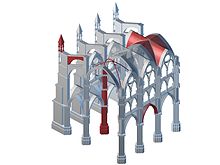
Groin vaults were built as early as the Roman Empire . The first ribbed vaults emerged in Norman architecture , in England even from the beginning with pointed belt arches . The oldest are yokes in the aisles of Durham Cathedral , from 1098, which apart from these girdles at the time only had round arches. The innovation was that in the vault with a square floor plan, two round arches were placed in a cross shape over the two diagonals, mostly with a decorative keystone at the intersection. This improved the stability of the vault , and the vault shells could be thinner and therefore lighter. The belt and shield arches over the four outer sides were built pointed upwards and could thus have the same height as the two longer and higher round arches above the diagonals. However, in most of the ribbed vaults, the vertices of the vaulted quarters rise from the outer sides to the central keystone. The ribs allowed any number of intermediate shapes between a cross vault and a domed vault ( domical vault ). During construction, the vault caps between the cross ribs could now be freely bricked up without creating full cladding. It is not uncommon for the ribs to be pointed. It became possible to create a vaulted yoke over a rectangular floor plan instead of just over a square floor plan as in the Romanesque groin vault. As the style continued to develop, more complex and intricate shapes such as B. Mesh vault created. The use of vaulted ribs remained characteristic of the style.
Pointed arch
The pointed arch is considered to be a central element of Gothic architecture, which is why it used to be called the "pointed arch style". Pointed arches are already known as a single element from the Romanesque period, but the use of round arches still prevailed there. The pointed arch is structurally an approximation of the arch shape, which corresponds to the favorable static force distribution of a parabola . Pointed arches determine the appearance of Gothic buildings and can be found practically throughout in the cross-section of all vaults, in the shape of the window and portal walls and in the tracery . Keel arches are a late Gothic pointed arch variant that is only possible with iron anchors; the convexity of the upper arch sections contradicts the basic principle of arch statics. In the Gothic secular building, cross-frame windows with rectangular walls without pointed arches were also common. Furthermore, as in the previous and the following styles, arches were built. The basket bow was added .
Buttress

The buttress is another central constructive and creative element of the rising church buildings. It is made up of buttresses and buttresses and is used in a basilica to absorb the lateral vaulting and the wind load from the central nave and high choir. The stability of the buttresses is increased by loads that can be designed as decorative elements such as pinnacles . The drains for rainwater and meltwater were also integrated into the buttress, which shoots away from the building via gargoyles in an arch and thus was kept away from the masonry and foundations. While the buttress had a primarily static function in the early Gothic period, it later developed into an important architectural element and is clearly emphasized. The choir and nave of Magdeburg Cathedral, the first Gothic-style basilica in Germany, manage without buttresses, and since the side aisles have free-standing transverse roofs, there are no hidden buttresses.
Dissolution of the wall

The Romanesque style still characterizes a massive, fortress-like construction of the wall and building structure, in which the wall thickness is often consciously emphasized. In the Gothic style, the lighter construction with pointed arches , ribbed vaults , buttresses and buttresses enabled the load-bearing elements to be relocated to the exterior, a significant reduction in the wall thickness and extensive opening of the walls with windows. The static function of the structural elements is deliberately overshadowed in the interior in order to create an illusion of lightness and weightlessness in the architecture.
In the interior, a walkway known as a triforium is let into the wall above the arcades to the side aisles and ambulatory , so that an “inner” and “outer” wall shell is created. This double-shell structure can, however, already be found in the Norman basilicas . Notre-Dame de Dijon in Burgundy offers an exemplary example of the Gothic double-shell wall construction . A large number of large windows were let into the outer wall, making the building appear light and flooded with light. In the High Gothic, finally, the rear wall of the triforium is also windowed through so that the wall appears completely broken. Nevertheless, practically every element of a Gothic building is load-bearing. The Gothic builders created new constructions through evolutionary further development based on the principle of “trial and error”. As a result, some buildings collapsed during the construction phase or had to be subsequently reinforced with additional force-dissipating elements due to cracks that appeared.
Emphasis on the vertical
This style feature is particularly pronounced in the French Gothic. As the highlight of the vaults of the reach Beauvais Cathedral m a peak height of 48.5, the Cologne Cathedral has such. B. 45 m. In comparison, the top of the vault of the Romanesque cathedral in Speyer is only 33 m high. The height increased in proportion to the width. In the Romanesque this relationship is e.g. B. at St. Michael in Hildesheim at 1: 1.9 and at the Speyer I section of the Speyer Cathedral at 1: 2.5. A jump then took place in the Gothic. The width / height ratio of Reims Cathedral is 1: 3 and that of Amiens Cathedral is 1: 3.3. In the English Gothic one did without large room heights with pronounced verticals and increased the building length in relation to the width.
Pillars and capitals
In the Romanesque era, the wall elevation still follows the ancient principle of “support and load”, in which the arched arcades are supported by columns, the capitals of which are based on a block as a basic shape and are often richly decorated with figures, ornaments or plant motifs.
In the Gothic these ancient columns are replaced by slender structured round pillars , which are often surrounded by services or themselves carry other services. The early Gothic bud capitals now have a goblet-like basic shape and are usually only decorated with plant motifs. With an increasing number of accompanying services, the bundle pillar develops , in which the capital recedes until the forms merge in the late Gothic period and the capital as an architectural element disappears completely, which means a complete departure from ancient building principles.
A special form of pillar arrangement in Gothic churches is the so-called single- pillar room .
Tracery and other decorative elements

Early Gothic windows still without tracery: Noyon , from 1150
Early Gothic windows still without tracery: Magdeburg Cathedral , from 1209
Window on Herford Minster ,
from left to right: Romanesque, late Gothic, early Gothic, late GothicBrick Gothic with ashlar tracery: Bruges Cathedral , late Gothic
Tracery made of iron since time immemorial: windows of Gdańsk St. Mary's Church , late Gothic
Tracery made of fired clay: Katharinenkirche in Brandenburg
The tracery is a typical architectural ornament of the high and late Gothic, which consists of geometric shapes, such as B. circles and arcs is developed. It can be made of brick or brick and is used in the arched field of windows, but also on parapets and wall surfaces. The invention of the tracery is also known as the "birth of the actual Gothic" and first appeared around 1215/20 at Reims Cathedral . In addition to pointed-arch tracery windows, there are also circular rose windows , which in the Gothic style can be increased to dimensions up to the width of the facade. Finally, in the late Gothic period, more intricate and complicated tracery forms were created in a variety of fish-bubble and flame patterns ( flamboyant ). The templates for many Gothic ornaments come from the world of plants. The oak leaves played a special role . Is often used on the tips of gables and towers a finial as an ornament (see also Wimperg ).
Builders and builders
Client
The owner of a bishop's church was the chapter (see cathedral chapter , collegiate chapter ) and not the bishop. The construction of collegiate and monastery churches was initiated by the abbot and the patron saint determined or influenced financially and also in terms of content. Chapter and bishop or city and city pastor agreed on the organization for the implementation of a bishop or parish church in the most varied of ways and ordered such. B. in Narbonne for the construction of the Narbonne Cathedral two canons and two clerics as administrators on a temporary basis. Builders were also referred to as church masters , procurators , magister fabrice , magister operis , operarius or also architectus .
The new style was advocated by the royal family, the urban bourgeoisie , the monarchically-oriented nobility, the church chapter and, in some cases, the bishops .
On the other hand stood the ruling classes of the feudal aristocracy, threatened with decline, with their lands, who saw in the Gothic cathedrals manifestations of a new, hostile power. Against this were those monastic orders whose power position in the countryside was endangered, initially the Cistercians , later - after 1220 - above all the new mendicant orders of the Dominicans and Franciscans , who often made themselves the mouthpiece of the urban lower classes - and of course the heretic movements were also against the new magnificent architecture. In Paris, therefore, there were serious conflicts between the cathedral clergy and the scholars of these orders, who teach at the university: Thomas Aquinas , Bonaventure von Bagnoregio and Albertus Magnus . And all of these orders developed different building concepts for their churches, which, so to speak, represent architectural models against the Gothic cathedrals.
Even among the proponents of the Gothic there was a dispute out of competition and prestige considerations. The bishops and the nobility wanted to manifest their power with the cathedrals. The up-and-coming citizens of the cities also wanted to make their pious contribution. The clergy and nobility did not tolerate this. They rejected the citizens' donations as the work of the cathedral should be their sole merit. There were even uprisings from the citizens who wanted to force their contribution. That is why citizens later built the civic churches named after them as a demonstration of their own power against the bishop, often near the cathedral. The attempt was made to outdo the cathedral.
builder
The head of the construction often were called foreman ( wercmeistere ) or builder ; they mostly emerged from the stonemasonry trade and were the medieval architects. Names like magister operis were also used. The master stonemason ( magister lapicidae ) and the master mason ( magister caementari ) as well as the sculptor were important in the execution . The masters of construction changed more frequently for each building, if only because of the long construction times.
Some important cathedral builders or master builders and stonemasons of the Gothic era became known:
- at Cologne Cathedral as Cologne cathedral builder, in particular Master Gerhard († 1271), Master Arnold († 1308), Johannes of Cologne , Master Michael († after 1387), Master Andreas von Everdingen († before 1412), Nikolaus van Bueren (1380–1445 ), Konrad Kuene van der Hallen (1400 / 10–1469)
- at St. Stephen's Cathedral in Vienna in particular Michael Knab (1340 / 50– after 1399), Wenzel Parler (before 1360–1404), Hans Puchsbaum (1390– after 1454), Anton Pilgram (1460–1515), Jörg Öchsl (around 1500),
- At the Regensburg Cathedral the master builder dynasty of the Roriczer, whose members occupied the position of master builder from 1415 to 1514 at the latest - starting with the master Wenczlaw (before 1415-1419), via Konrad Roriczer (1456- around 1476), to the brothers Matthäus (1476–1495) and Wolfgang Roriczer (1495–1514).
- William of Sens , builder around 1175 at Canterbury Cathedral and before that at Sens Cathedral
- Foreman Guerin of St. Denis Cathedral (13th century)
- Foreman Hugues Libergier (1229–1263) from the Abbey Church of St-Nicaise in Reims .
- Master craftsman Pierre de Montreuil (around 1250) of the Notre-Dame de Paris cathedral
- The Parler master builder family with, among others, Heinrich Parler the Elder (1300 / 1310-1370), Michael Parler (around 1330-1390), Johann the Younger (around 1359-1405) and Johann the Elder worked, for example, on Basel , Freiburg , Gmünder , and Strasbourg and Ulm Minster as well as St. Vitus Cathedral in Prague and St. Barbara Cathedral in Kutná Hora ; The term foreman arose from the name Parler .
The masters could often be recognized by their stonemason's mark, a mark that they put on their work in the Middle Ages.
Regional distribution and further development
In architecture, a distinction is made between early, high and late Gothic, which developed differently in the different regions:
| Early Gothic | High Gothic | Late Gothic | |
|---|---|---|---|
| France | 1140-1200 | 1200-1350 | 1350-1520 |
| England | 1170-1250 Early English |
1250-1350 Decorated |
1350 - approx. 1550 Perpendicular |
| Italy | since 1200 | ||
| Holy Roman Empire | 1220-1250 | 1250-1350 | 1350 - approx. 1520/30 |
When the Renaissance spread north, east and west of the Alps at the beginning of the 16th century , the Gothic style quickly lost its influence.
Regional style terms

In addition to the general temporal distinction between early, high and late Gothic, some special terms are used for certain regional style characteristics or building techniques:
- Rayonnant , French for radiant , stands for the high Gothic style phase from approx. 1230 to 1350 with maximally large window areas and a translucent triforium. In the tracery , the rose windows are divided into radially radiating strips, as in the rose windows of the Notre-Dame de Paris cathedral.
- As Flamboyant the last stage of the Late Gothic style in France, is Flanders and England respectively.
- The Decorated Style (also Decorated Period ) is a phase in English Gothic that lasted from 1250 to 1370.
- The Perpendicular Style is a late Gothic style that is typical for England.
- The brick Gothic refers to the implementation of the Gothic with building brick, 13.-16th century North German brick Gothic architecture in northern Germany and the Baltic region distributed without this additional designation but also in other regions (see below the section on brick Gothic ).
- The German special Gothic is a controversial, ideologized style designation of the Gothic of the 14th and 15th centuries in Germany.
- The Chiaramont style is a Gothic style of architecture from the 14th century in Sicily .
- As Nachgotik the continuation of Gothic architecture after his actual age at the time of the Renaissance and also the is Baroque referred.
- The neo-Gothic or neo-Gothic is one of the earliest styles of historicism in the 19th century. Their dependent formal language was based on an idealized image of the medieval to the Gothic.
France
Around the beginning of the 13th century, the episcopal churches of Chartres (from 1194), Reims (from 1211) and Amiens (from 1218) emerged as a three-aisled basilica with a choir, three-storey wall elevation with triforium, double tower facade and Tracery windows. The large building of Bourges Cathedral (from 1195) on the threshold of the High Gothic period also brought some innovations, but remained unique in its shape as a five-nave basilica without transepts. The dissolution of the wall reached a climax due to the double-shell wall construction in Burgundy, as in the cathedrals of Lausanne (today Switzerland, from 1190) and Auxerre (from 1215) or at the Notre-Dame parish church in Dijon (from 1230).
The high Gothic phase begins with the introduction of tracery windows around 1215/20 on the choir of Reims Cathedral . The high Gothic Rayonnant style was created around 1230 with wall surfaces largely dissolved by windows, the windowing of the triforium (first around 1230 on the nave of St.-Denis and in Amiens ) and the radial tracery of the window rosettes . Amiens Cathedral , which was largely completed in the 13th century, set new standards with a central nave height of 42.30 m. The pursuit of size and maximization of the window areas culminated in the cathedral of Beauvais , begun in 1247 , which surpassed Amiens with a choir of over 46 m high nave, but whose vaults collapsed in part as early as 1287. The Gothic gigantism in Beauvais was not over until 1569, when a 150 m high crossing tower was placed on the repaired choir, which also collapsed after four years. Except for the choir and the transepts, the church was never completed.
In addition to the sometimes huge cathedrals, large monastery churches as well as thousands of parish churches and chapels such as the famous Parisian Sainte-Chapelle (1244–1248), whose vaults seem to float on luminous “glass walls”, were built.

Some art historians put the forerunners of the French late Gothic period as early as around 1300 . There is no longer any significant development in the building types, the scheme of the “cathedral gothic” is rather simplified. The Hundred Years War (1337–1453) with England brought building activity to a largely standstill after the first third of the 15th century. A major new cathedral was only started in 1434 in Nantes , but numerous large parish churches were built for the city's population, which was growing rapidly after the end of the war. However, many interrupted large buildings were also continued and completed. Since most of the large churches were built for centuries, many buildings also have elements from the various Gothic eras. They did not stick to the original plans slavishly, but continued to work in the current style.
From around 1350, the late Gothic flamboyant style came to the fore as a decorative style, which got its name from the flame-shaped tracery and decorative forms that often cover huge surfaces. Some large buildings have now been completed with magnificent west facades, and transept facades were also created in the flamboyant style. An early flamboyant building is the Saint-Ouen Abbey in Rouen (from 1318). Further examples are e.g. B. the basilica Notre-Dame de L'Épine (from approx. 1405), the abbey church of Vendôme , the chapel of Brou (from 1513) or the transepts of the cathedral of Senlis (16th century).
The deep anchoring of the Gothic in France can be seen in its survival in the post-Gothic , which produced buildings such as the Cathedral of Orléans (from 1601) or Saint Eustache in Paris (1532–1649) in the Renaissance period .
- Early Gothic in France and Germany
Loft of Laon Cathedral 1155–1235
Loft of Limburg Cathedral , (approx. 1190) –1235
Germany
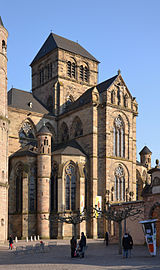


During the French early Gothic period, Germany began only one significant work in this style, from around 1180 the Gothic reconstruction of Limburg Cathedral . The first large-scale building started in Gothic style, the Magdeburg Cathedral (from 1207/1209), dates back to the French High Gothic period, but its oldest parts still have clearly early Gothic features, the ambulatory choir has the cross-section of a gallery basilica and unmistakable pointed arched windows. In contrast to most of the Gothic basilicas , Magdeburg Cathedral does not have flying buttresses , which is what followed in some neighboring buildings to the east. It was not until the end of the High Middle Ages that the Gothic style became generally accepted in Germany. However, in several late Romanesque churches , the traditional overall proportions and the arched portals and windows were retained, but the structurally advantageous innovation of the pointed arched rib vault was adopted for the ceilings. The central building of the Liebfrauenkirche in Trier (from approx. 1230), the abbey church of St. Mauritius in Tholey (from approx. 1230) and the hall church of the Elisabethkirche in Marburg (from 1235) are regarded as the first purely Gothic church buildings on today's German territory . The early Gothic Cistercian monastery church Haina , which may also precede the Marburg church, is closely connected to the Elisabeth Church. Also around 1230, the choir of the Wetzlar Cathedral and the nave of the Freiburg Minster were started as Gothic renovation projects . In the case of the Freiburg Minster, Gothic forms could have been conveyed by the Cistercian monastery church Tennenbach , but their chronological position has not been clarified. In the case of Paderborn Cathedral, the two western bays of which still correspond to the concept of a Romanesque basilica, Gothic construction continued from 1231, however, not according to the model of the Île de France, but according to the model of the Cathedral of Poitiers .
According to the scheme of the French cathedral Gothic, the high Gothic nave of the cathedral of Strasbourg was built in 1245-1275 , the large-scale west facade of which followed from 1277, which is on a par with the best achievements of French architects. Although Strasbourg is now part of France, historically it is a major work of German High Gothic. In 1248 the cathedral was built for the Cologne Cathedral , which tried to surpass its model of the Amiens Cathedral with a five-aisled floor plan and enormous dimensions . In the Middle Ages, the cathedral was not even half finished and could only be completed in the 19th century according to the original plans as one of the world's largest churches. The Lübeck Marienkirche , built in 1250–1350, should be mentioned as a hardly less ambitious building. As a parish church in the form of a French cathedral and its size and height, it should demonstrate its primacy over the Lübeck Episcopal Church. By adapting it to the local brick building material, St. Mary's Church also became the initial brick Gothic building for northern Germany and the Baltic region. Around 1260, after the Reims model, the renovation of the Halberstadt Cathedral began , of which only three nave bays could initially be realized; the rest of the building dragged on until around 1500. The only building in Bavaria based on the French cathedral scheme was the Regensburg Cathedral, based on the model of St-Urbain in Troyes, which began around 1285/90 .
In addition to the large episcopal churches, numerous parish churches quickly emerged in the cities, sometimes reaching or even exceeding the dimensions of the cathedral buildings. In Freiburg im Breisgau , the cathedral was an early major work of German Gothic, whose main tower, completed around 1330 with its openwork helmet, became the model for many later tower solutions and which was one of the few large Gothic towers to be completed in the Middle Ages. From 1377 onwards, the Ulm Minster advanced to even larger dimensions , the main tower of which, as the world's highest church tower, could not be completed until the 19th century. The Cistercian monastery church of Altenberg , which began in 1259, stands out as a monastery church, which expresses Cistercian “modesty” without towers and with reduced architectural decoration, but trumps in its dimensions.
The German and Central European Gothic had from the early Gothic (reconstruction of Limburg Cathedral based on the model of the cathedral of Laon ) to the late Gothic, between close reference to French models ( St. Barbara in Kutná Hora , Bohemia , 1388–1588) and own ideas. The German preference for hall churches was hardly shared in the Rhineland and in the southwestern Baltic Sea cities from Lübeck to Stralsund, at least one large brick basilica with buttresses was built in each case. For deviations from the example of Capetian France , including the abandonment of the ambulatory and chapel wreath, there is the term "Reduction Gothic". The term “ German special Gothic ” is outdated.
The hall enabled the development of elaborate vaulting systems, in which the delimitation of the individual yokes receded further and further, which merge into a single space and are often spanned by the magnificent mesh or loop rib vaults ( Annaberg , Freiberg ). The late Gothic in particular created significant examples here. The southern German imperial cities, especially Nuremberg and Regensburg as well as the Hanseatic cities on the Baltic coast, especially Lübeck and Stralsund , are developing into local centers of Gothic architecture .
For a long time, especially in the 19th century, the Gothic was considered to be a typically German style. After the Wars of Liberation against Napoleon, Gothic architecture became the epitome of a primeval German, Christian, medieval world order. This romantic dream image was raised to the positive counter-image. Cologne Cathedral, which was not yet completed at that time, became the architectural epitome of German greatness and at the same time the Gothic was reinterpreted as a German style. At the height of the glorification of the German Gothic, Franz Theodor Kugler was the first to publicly state that the home region of the Gothic is northern France.
Strasbourg Cathedral , a major work of German high Gothic, completed from 1245, north tower in 1439.
Cologne Cathedral , general view of the west facade completed in the 19th century
West facade of Altenberg Cathedral , from 1259
Regensburg Cathedral of St. Peter , only cathedral of French scheme in Bavaria , from 1273.
Nuremberg Frauenkirche , from 1350.
Ulm Minster , from 1377, with the highest church tower in the world, since 1890.
England


The English Gothic cathedrals often have two transepts and a straight choir end in the east . The choir was greatly lengthened and a Lady Chapel was often added instead of an apse. What is particularly remarkable about the exterior of the cathedrals are the wide west facades. It is also noticeable that the crossing tower often towers above the main towers. Another peculiarity of the English Gothic is the special emphasis on length in contrast to the more obvious striving up the continent. The English buildings were almost without exception built with three naves. The aim was not to increase the area by means of double aisles or side chapels; instead, there were extreme length-width ratios. The Abbey Church of St. Albans and Winchester Cathedral reach lengths of about 170 m.
On the island, from around 1175 onwards, “modern” continental designs were adopted, which were combined with the native Anglo- Norman tradition ( Norman Style ) to form the Early English Period (1175–1260) and were brought into the country in particular by the Cistercian order . One of the stylistic features of the Early English Style , which is very sparse, is the ribbed vault . In the 13th century, the development of more complex vault forms (star vaults) and more decorative patterns of the ribs (e.g. crown ribs) began. The choir of Canterbury Cathedral, built by William of Sens between 1175 and 1184, is considered to be the first English Gothic building .
During the Decorated Style (1250–1370) there was hardly a wall surface without tracery facing ; The vault ribs also join together to form richer patterns (star or net vaults). The pointed arch becomes the keel arch . The raised light path allows the installation of larger, colored windows and thus illuminates the interior. Examples of the decorated style can be found in Westminster Abbey in London (choir, begun 1246) and in the cathedrals of York (about 1290-1340) and Wells (about 1290-1340). A masterpiece is the 1321-1353 built Vierungs - octagon of the cathedral in Ely with its tower lantern final.
The Perpendicular Style (1330–1560) (Latin perpendiculum: plumb line) took back the ornamentation of the Decorated Style in favor of a clear, geometric style with an emphasis on space. The windows became very wide, often covered the entire east side and were given a very flat pointed arch, the Tudor arch , which developed because normal pointed arches would not have found room with the new dimensions of the windows. The fan vault occurs.
The new style was first realized in Gloucester Cathedral (choir, cloister with fan vault, 1337-1357). Other examples include Winchester Cathedral (nave, begun 1394), King's College Chapel in Cambridge (begun 1446) and Henry VII Chapel in Westminster Abbey (1503-1519). The Perpendicular Style was built in England for over 200 years, well beyond the end of the Middle Ages. In 1640, for example, the stairwell of Christ Church College in Oxford was built with a fan vault. In the Tudor Style , the Perpendicular Style mixed with forms of the Renaissance . England is the only European country in which the Gothic style never completely died out, but in some cases continued to exist in the country and was taken up again in the Gothic Revival .
The typical layout of an English cathedral based on Salisbury Cathedral .
Rood screen in Bristol's Gothic Cathedral
The situation in Ireland is similar: early Gothic Christ Church Cathedral in Dublin
Italy
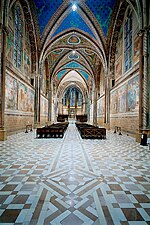


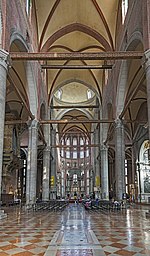

In the Italian architecture of the Middle Ages, which remained strongly based on the ancient models, there was a direct development from the Romanesque , sometimes also referred to as Protenaissance , to the Early Renaissance ( Quattrocento ) in the early 15th century. The French or Central European Gothic architectural style was neither fully adopted in Italy nor was it ever predominant.
The Italian Gothic shows its own expression, which lacks many features of the French cathedral Gothic. As a rule, there were no rooms with an emphasis on heights, large openings in the walls with large tracery windows, open buttresses, rich architectural decorations, large figure portals and double tower facades. Italy preferred clear and straight structures with large, often richly painted wall surfaces, as well as lower and often wider rooms. The exterior structures made of typical building materials such as B. Marble and brick are often kept very simple except for the facade.
For the first time, the Cistercians imported the abbey churches of Fossanova (1187–1208), the ribbed vaulted monastery church Casamari (1203–1217) and the Abbey of San Galgano (from 1224) Gothic structures to Italy. Under the impression of the Cistercian architecture, the Italian Gothic and the architecture of the mendicant order were initiated by the mendicant orders with the construction of the Gothic upper church of San Francesco in Assisi. The building sculpture was reduced to the bare essentials and the large walls were designed with extensive fresco cycles . The church buildings of the Franciscans and Dominicans were often in competition with one another. B. the Franciscan Frari Church and the Dominican San Zanipolo in Venice. This did not lead, as in France, to a constant increase in a uniform concept, but to self-portrayal through originality.
In Siena , the Romanesque cathedral was Gothicized from the early 13th century. Particularly noteworthy here is Giovanni Pisano's three-portal west facade (from 1284), which probably goes back to French models. Another prominent building is the Romanesque-Byzantine St. Anthony's Basilica in Padua.
From 1387 the Milan Cathedral was built , which, as an exception, was strongly oriented towards the Central European Gothic. The interior of the huge, 157 m long five-aisled building is reminiscent of the cathedral of Bourges but also of local Romanesque models ( cathedral of Piacenza ). The city lord Gian Galeazzo Visconti wanted to manifest the power and influence of his city and his family through one of the largest cathedrals in Europe. Its Gothic forms of construction and decoration met with great resistance from the local population and bitter controversy arose among the builders. For example, Heinrich Parler, hurt, withdrew from the construction company after his proposal to increase the central nave was rejected as too "un-Italian". As a rival building to Milan, the five-aisled Basilica San Petronio in Bologna was built from 1390 onwards, also in huge dimensions of 132 m length and 45 m vault height , whose simple, clearly structured interior is again typical of the Italian Gothic.
The communal palaces of the Italian city republics , some of which were fortress-like and often decorated with a high belfry , competed with the church buildings . Significant Gothic secular buildings are z. B. the Palazzo Vecchio (1299–1314) and the Loggia dei Lanzi (1376–1382) in Florence, the Palazzo Pubblico in Siena (1297–1310) and the Doge's Palace (from 1340) in Venice.
Padua: St. Anthony's Basilica , from 1290
Sta-Maria della Spina in Pisa , from 1323
Five-nave nave of the Basilica of San Petronio in Bologna
Palazzo Pubblico of Siena
Netherlands and Belgium
Starting from Tournai and using limestone from the Tournai area , a Romanesque-Gothic transition style, the Scheldt Gothic, developed in Flanders , which at that time was still a French fiefdom , which extended to northern Germany.
The choir of the Utrecht Cathedral was built from 1254 at the same time by the same master builders as that of the Cologne Cathedral (from 1248) and is accordingly very similar. The western parts of the Utrecht Cathedral (the nave of which collapsed in a hurricane in 1674 and was then removed piece by piece) are essentially made of brick, which also forms the outer skin of two chapels and parts of the tower.
In the course of the Gothic period in Flanders and almost the entire area of what is now the Netherlands, the stone imported from more southerly regions, especially tufa from the Eifel , was increasingly displaced by brick , the use of which there had already begun in the Romanesque, a little later than in northern Germany . The Count's Palace in the Binnenhof in The Hague , the center of power for the County of Holland, is one of the most important works of Dutch brick construction. The Romanesque eastern part ("Rolzaal") was built around 1250, the early Gothic knight's hall from 1280–1295, at the time when the construction of the Prussian Marienburg began.
In the late Gothic period, in the Duchy of Brabant, the so-called Brabant Gothic , which in church architecture ( Cathedral of Herzogenbosch , Cathedral of Antwerp , Nikolaaskerk in Gent and Martinkerk in Ypres ) dispensed with building elements compared to French models and is therefore referred to as Reduction Gothic , in secular buildings but unfolded a splendor hardly known elsewhere. Examples are the town halls of Leuven and Mechelen . One of the most important builders was Jehan d'Oisy from Picardy in France . Particularly important churches and town hall facades often follow the Brabant Gothic style in material and design, where brickwork was otherwise used. Bruges in particular has important works of the brick Gothic, but even more numerous of the brick Gothic.
In Germany, the Xanten Cathedral is clearly influenced by the Dutch Gothic; Other buildings in the Lower Rhine region are also worth mentioning here (in Kalkar St. Nicolai and several brick houses, mainly made of tuff, the Willibrordi Cathedral in Wesel and the Salvator Church in Duisburg, mostly made of brick, the collegiate church in Kleve and the Maria Magdalena Church in Goch ). Decorative layers of natural stone, mostly tuff, and brick can be found on numerous buildings, such as the Nieuwe Kerk in Amsterdam and the church of Alt St. Martinus in Stommeln near Cologne.
The Maas Gothic also developed in the collegiate area of the Diocese of Liège , which today extends over parts of the Netherlands and Belgium .
Knight's Hall in The Hague , ca.1280
Oude Kerk in Delft , South Holland
Grote Kerk in Workum , Friesland Province
Choir (from 1254), transept and tower of the Utrecht Cathedral
Town hall in Culemborg am Lek , Gelderland
Petruskerk in Oirschot , Noord-Brabant
Brussels Cathedral , 15th century facade
Church of Our Lady in Bruges , from 1210, stone carvings based on the French model, tuff stone, brick
St. Salvator's Cathedral in Bruges from 1280, yellow brick
City Hall of Leuven , 1439–1468
Austria
The only Gothic cathedral in Austria is St. Stephen's Cathedral in Vienna , a large hall with two planned, huge choir side towers, of which only the south tower was completed. Important monastery churches with hall choirs can be found in Heiligenkreuz and Zwettl ; large Gothic parish churches are St. Stephan in Braunau and St. Jakob in Villach. The parish church in Königswiesen and the parish church in Weistrach stand on the border between the late Gothic and the Renaissance and, with their looping ribs, show an almost “baroque” dynamic of form. These two churches were built at the beginning of the 16th century and are characterized by their autonomous vault design.
Eastern Europe
In the Gothic sacred architecture of Poland , Bohemia , Moravia , Hungary and other East and East Central European countries, local special developments mix with the basic structures imported from Western Europe and Germany. In the cities and regions dominated by the German bourgeoisie, Central European influences predominated. Due to the trade relations of the Baltic Sea cities, Dutch elements also came to this area; an example is the Marienkirche in Gdańsk .
In Bohemia, the great cathedral on Prague's Hradschin remained unfinished until the early 20th century. The high to late Gothic choir of St. Vitus Cathedral was started by a French master and continued by Peter Parler . The highlight of Bohemian architecture is the St. Vitus Cathedral, the "Cathedral" of Kuttenberg (Kutna Hora) , which is consecrated to St. The nearby Kolín on the Elbe also has an important choir building for the Parlerschule. In Most (Brüx) , the late Gothic deanery church was moved about 800 meters in a spectacular action to save the richly vaulted hall from open-cast brown coal mining.
The former Greater and Lesser Poland also has numerous Gothic religious buildings. The brick dominates as a building material; The Cistercian architecture in particular had a long history here. In the case of the great cathedral (from 1320) on the Wawel in Krakow , these influences have been partially blurred by later renovations. The two-aisled, star-vaulted church in Wiślica (around 1350) refers to models of secular monastic architecture (refectories, chapter rooms).
The Krakow Marienkirche was the parish church of the German community in the Middle Ages. The steep brick basilica has an original late Gothic tower spire, which is crowned by a golden crown. The Poznan Cathedral has a “French” ambulatory choir ; Today, however, due to the devastating destruction of the Second World War, the building is mainly a reconstruction of the original medieval condition. Several Gothic churches in Poland, not only those of special orders, have no or only a moderately high bell tower, but representative gables.
Vitus Cathedral in Prague , from 1344
St. Barbara in Kutná Hora (end of the 14th century)
Wenceslas Cathedral in Olomouc , 13-14th centuries Century
Elisabeth Cathedral in Košice , 15th century, a middle part of a basilica and a central building
St. Martin and Nikolai in Bydgoszcz , 1466–1502
Church of Exaltation of the Cross in Koło , 14./15. Century
Sandomierz Cathedral , around 1360, baroque gable 1670
St. Mary's Church in Gdansk , 1343–1502
Latin Cathedral of Lviv (Lemberg), Ukraine , 1370-1474
Gothic vaults of the Orthodox Cathedral of Vilnius , which was later redesigned from the outside , from 1346
The Baltic States ( Estonia , Latvia and Lithuania ) have some larger brick churches of northern German or Westphalian characteristics in the old Hanseatic cities of Riga and Reval (Tallinn). Far removed from the German models, however, is the magnificent brick facade with elements of the "flame Gothic" of the Lithuanian St. Anne's Church in Vilnius .
In the Slavic parts of the Grand Duchy of Lithuania , several partly Catholic, partly Orthodox churches and one or the other castle in a mixture of Gothic, Renaissance and Byzantine elements, also known as Belarusian Gothic , were built in the first half of the 16th century .
In Romania , the Gothic architectural style was difficult to develop due to the fact that it belonged to the Orthodox culture. Still, the Romanian Orthodox Church is the only one among the Orthodox churches that has accepted Gothic or Gothic-influenced structures. The Gothic remained mainly limited to Transylvania , which at the time of the Gothic belonged to the Kingdom of Hungary. The influence of Western culture on the Romanians can be demonstrated here in the Romanian Orthodox wooden churches of Maramures and the Apuseni Mountains . Outside the Carpathian Arc, the Gothic can be found in some of the Moldavian monasteries as well as in isolated churches from Wallachia and Moldavia .
In Transylvania, on the other hand, there are numerous buildings by the German and partly the Hungarian minority that were built in the Gothic style. The largest and most famous of these is the Black Church in Kronstadt. Not only is it the largest Gothic cathedral in south-east Europe , but also the most south-east. At the same time, it is the largest cult building between St. Stephen's Cathedral in Vienna and Hagia Sophia in Istanbul .
- Romanian Orthodox churches in the Gothic style
Putna Monastery in the north of the Vltava
Saint Spiridon Church in Bucharest
- Evangelical Lutheran and Reformed Churches in Transylvania
Black Church in Kronstadt , Transylvania
City parish church in Sibiu , Transylvania
High Gothic fortified church in Biertan , Transylvania
Calvary Church in Cluj-Napoca , Transylvania
In the other predominantly Christian-Orthodox states of Eastern and Southeastern Europe, the Gothic could not develop due to belonging to the Orthodox (Byzantine) cultural area.
Switzerland
The Swiss Gothic in western Switzerland is naturally oriented towards France ( Lausanne , Geneva ). German-speaking Switzerland has three larger Gothic sacred buildings in the mines of Basel , Bern and Freiburg im Üechtland ( Friborg in French , originally German-speaking). Bern and Freiburg i.Ü. with their single-tower facades are reminiscent of the cathedral in Freiburg im Breisgau . The Basler Münster is largely Romanesque. The high choir was rebuilt in Gothic style after a severe earthquake (1356). The west towers are also from a later period.
Lausanne Cathedral , from around 1170, the most important early Gothic building in Switzerland
Former Franciscan Church Barfüsserkirche in Basel, after 1298
Late Romanesque Basel minster with Gothic additions, after 1356–1500
Late Gothic nave of the Bern Minster , from 1421
Romanesque-Gothic cloister of the Hauterive monastery near Friborg, 1150–1330

In Denmark the reception of the French Gothic began even earlier than in Germany. The brick dome of Roskilde with its ambulatory choir looks like an offshoot of the German brick Gothic at first glance , but clearly refers to direct western models, such as Noyon and Laon. The further development was largely dependent on northern Germany and Westphalia. The simple stepped gables of numerous Danish brick churches are a special feature. Larger cathedral buildings can also be found in Aarhus and Odense . The Danish late Gothic preferred the type of pseudo-basilica (relay hall). The interior of these churches is mostly whitewashed in the northern German style.
In Sweden , the large cathedral buildings in Uppsala and Skara underwent major neo-Gothic changes in the 19th century. In Uppsala this conversion was largely dismantled around 1970. Here, too, direct French influence becomes clear, which, however, like its Danish counterpart Roskilde, remained without successors. In addition to Lübeck (Malmö), the Westphalian hall churches in particular shaped the style; Both back stone (Sigtuna) and stone (Linköping) are used as building materials. The north German hall construction was also often trend-setting, for example in Västerås or Vadstena; the Brigitten monastery church there is one of the most important sacred buildings in Scandinavia.
Gotland still has 92 medieval, partly Romanesque and partly Gothic churches, in which regular services are still held. They follow Westphalian models, but have developed into an architectural language of their own. The most important example is in the middle of the heavily fortified old trading town of Visby . The large and old churches of this medieval city, which is unique in Scandinavia, have only been preserved as ruins, and the remaining 91 churches are in the countryside.
The main Gothic work in Finland is the large cathedral building in Turku (Åbo), a steep brick basilica according to the North German-Swedish scheme (vault height in the central nave 24 m). The other sacred buildings are also largely based on Sweden for political and cultural reasons.
In Trondheim Cathedral, Norway has a larger cathedral based on the English Gothic; however, the typically English screen façade is mostly an addition from the last century.
The Skara Cathedral
The Church of Saint Mary in Visby
The Turku Cathedral
Spain and Portugal
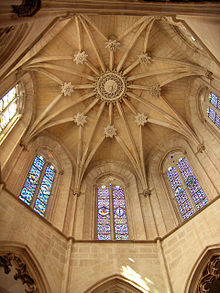
The early large Spanish cathedrals in Burgos , Toledo and León still clearly follow the French models; Only from around 1300 did a more distinct development of the Spanish sacred architecture begin.
1298 was the construction Cathedral of Barcelona started their longhouse already approaching the hall form. In 1329 the large seafarers' church of Santa Maria del Mar followed , also a huge "relay hall". Typical of the Aragonese-Catalan Gothic is the simple, even sparse exterior of the churches, which often look like fortresses. From 1312, southern French masters began building the choir of Girona Cathedral . From 1417 a huge, single-nave nave was added to it. With a span of 23 meters, the widest Gothic vault was created here; the vault height is 34 meters.
The main work of Mallorcan medieval architecture is the Santa María Cathedral in Palma , which was started around 1300. The huge three-aisled basilica is about 110 meters long. The visible side is the longitudinal front facing the sea with its dense series of pinned buttresses and double buttresses.
After the Reconquista, Andalusia created the cathedral in Seville, one of the mightiest sacred buildings in Europe and the largest Gothic church in the world. Started in 1401, construction dragged on until 1519. It was built on the foundations of the Islamic mosque , whose large minaret , the Giralda , was transformed into a bell tower. Here, too, the five-nave interior was approximated to the shape of the hall; the exterior is structured by an elaborate system of buttresses and arches.

When the Renaissance began to establish itself in other places, the late to post-Gothic cathedrals of Salamanca , Segovia and Plasencia were built in the 16th century . Up until the beginning of the 18th century, Gothic was regarded as the “modern” architectural language; however, the Renaissance was on an equal footing as a style. The Gothic represented the victory of Christianity over Islam, which is why elements of this medieval architectural style were used for a long time. This “post-Gothic” naturally contains numerous modifications of the classical forms. The cathedral of Santa María in Astorga, begun in 1477, has a late Gothic character
There are also a number of outstanding works of Gothic architecture in Portugal . Initially, the mendicant orders were style-defining; Around 1300 the court and later the nobility began to award contracts. In 1330 Sta. Consecrated to Clara in Coimbra , the cloister of the cathedral in Évora started around 1350 . In 1388 the planning of the unfinished Batalha monastery began . The king had praised the construction of the Dominican convent as thanks for the victory over the Castilian army at Aljubarrota . It later served as a royal burial place. The church of the Hieronymites Monastery in Belém (1517) is a large, reticulated post-Gothic hall . The monastery is - like the famous Torre de Bélem - a good example of the “ Manueline architecture ”, which forms the end of the Portuguese Gothic. Unlike in Spain, Moorish and Islamic influences ( Mudéjar style ) are rather the exception in Portugal.
Orient
The Crusaders brought the Gothic architectural style to the Middle East as well. In Cyprus in particular, there are several structures they have built. There are also a few on and near the east coast of the Mediterranean Sea.
Haydarpaşa Mosque in Nicosia, built in the 14th century as the Church of St. Catherine
City gate of Caesarea Maritima, reactivated by the crusaders, near Hadera , Israel , 12th century.
Secular buildings
In contrast to the Romanesque, numerous secular buildings have survived from the Gothic period . While the sacred building led the Gothic architectural development, the secular building followed the new developments and transferred many architectural and construction elements to secular building types. In contrast to church buildings, functionality usually took precedence over artistic design. Features of the profane are z. B. a mostly flat wall design as well as windows and doors with profiled walls, which can be ogival or, like the cross-top window, also rectangular. In addition to stone ribbed vaults, there are also flat wooden ceilings or wooden vaults. Gothic secular buildings were typically developed from the interior, which dictate the floor plan and the position of the window axes and doors in the facade. As a result, the floor plans and facades are usually asymmetrical, which can range from slight irregularities to complete asymmetry. Representative buildings such as town halls could also have high bell towers ( belfry ). Typical elements of Gothic secular buildings are z. B. stepped gable , also called stair gable or cat stairs, stair towers and bay windows , which also occur as corner turrets.
Transformation of the castle into a palace
The change in warfare (firearms, mercenary armies) reduced the importance of fortifications in the late Middle Ages , while the will to represent was added. As a result, in the course of the Gothic period, the military purpose of the prince's castle increasingly took a back seat to the residential purpose. The Gothic castle construction took over numerous elements of the sacred architecture, occasionally even cloister-like inner courtyards were built. Numerous halls and chambers have now been vaulted. Rows of windows adorned with tracery broke through the outer walls and richly decorated Gothic chapels were built. The Marienburg of the Teutonic Order in Poland is considered to be the largest secular building of the Gothic . Secular masterpieces such as the Albrechtsburg in Meißen , the Wladislavsaal of Prague Castle or the richly decorated castles in Amboise and Josselin and the ducal palace in Poitiers (around 1390) in France were created especially in the late Gothic period . A special form of Gothic palace construction developed in Venice, e.g. B. at the Doge's Palace , where in addition to the use of local building materials marble and brick z. B. twisted columns and oriental-looking pointed arches occur. This formal language can be explained by the influence of the Orient and Byzantium on Venice, which arose through trade with these areas.
Castel del Monte Frederick II. In Apulia , 1240-1250, Gothic and proto Renaissance , a palace without military installations
Avignon : Papal Palace , former papal residence, 1334–1370
British royal residence at Windsor Castle , from 1350
Marienburg (Malbork) , Grand Master's Palace 1383–1393
The Ca 'd'Oro in Venice, 1421–1442
Albrechtsburg in Meißen, late Gothic splendor before the transition to the Renaissance , 1471–1485
Wing of Louis XII. from Blois Castle , 1498-1503, late Gothic Flamboyant style with the transition to the Renaissance
Fortifications

The city fortifications became the most important building task for the city citizens. In Germany, many cities received their city and fortification rights in the early or high Gothic period. From the second half of the 12th century, solid walls as well as defense towers and gate structures were built. With the spread of firearms, the defense towers changed from tall structures to low, massive gun turrets, and the gate structures developed into complex gate castles . Extensive city walls are preserved today, especially in Franconia ( Rothenburg ob der Tauber , Dinkelsbühl , Nuremberg ) or z. B. in Carcassonne (France).
Municipal representative and functional buildings
With the increasing importance of the medieval city, there was a need for functional urban buildings. The town hall was a multi-purpose building for the council chamber, ballroom, bar, trade (e.g. Lübeck from 1230, Bruges from 1376). The increasing need for representation of wealthy cities was reflected in the size and cost of the buildings (Brussels from 1402, Leuven from 1439), these highlights of urban secular architecture are therefore sometimes referred to as the “cathedrals of the bourgeoisie”. Above all in Flanders and Italy, a belfry symbolized the power of the city - often rivaling church towers in height. Depending on the size and importance of the city other community buildings were added as cloth - and meat market (Ypres from 1250, Antwerp from 1509 onwards), guild and guild houses (Ghent / House of free Schiffer from 1530), dance and wedding houses (Köln / Gürzenich from 1447) or Kornhäuser .
Schools and hospitals were mostly run by monasteries, especially Franciscans, which is why these functional buildings are often integrated into the city monasteries.
Historic town hall in Münster - tracery made of sandstone
Rathaus Tangermuende , Saxony-Anhalt - tracery from brick
Stadhuis (City Hall) of the Hanseatic City of Doesburg , Gelderland , NL
Perugia: Assembly room of city leaders ( Palazzo dei Priori ), 1293–1297
Government palace Palazzo Vecchio of Florence with belfry, from 1299
Siena : City Hall with Torre dell Mangia, 1338–1348
Brussels : City Hall, from 1402
Bruges : Cloth Hall with Belfry, from 1282, upper floor from 1482
Lübeck: Town Hall , from 1230
Kölner Gürzenich (Tanzhaus), (1441–1447, reconstruction after 1945)
Historic department store in Freiburg / Br., From 1520
Holy Spirit Hospital in Lübeck , from 1240
Nuremberg: Heilig-Geist-Spital (from 1332)
former hospital (Hôtel-Dieu) of Beaune (from 1443)
Residential buildings
Gothic residential construction in western, central and northern Europe was still largely characterized by half-timbered houses , but numerous towns and markets with houses made of brick or brick emerged - especially in southern Germany, Austria and eastern central Europe. A characteristic of such Gothic cities that has been preserved to this day are the partially vaulted arcades, which were previously mostly used as covered “sales stands”. In Bavaria and Austria , Landshut , Burghausen , Neuötting , Braunau and Innsbruck should be mentioned here. The numerous cities of Poland, Bohemia and Moravia that were built in the course of the colonization in the east have also retained their Gothic ground plans. often such colonial cities were built around huge marketplaces (rings). Examples are Domažlice , Telč , Budweis , Pilsen and Cracow . In the Alpine region, the Ladins also know the Gothic house in farmhouses.
Brick gothic
In a large region consisting of Flanders , the Netherlands , north and north-east Germany, Scandinavia and Poland , Gothic buildings were largely made of brick . The North German brick Gothic is particularly well known . This term is also related to the regions bordering northern and eastern Germany . In Germany, for example, Lübeck (Marienkirche), Stralsund , Wismar , Greifswald and Bad Doberan have large sacred buildings made of this building material . The Marienkirche in Lübeck in particular served as a model for numerous other churches throughout North and Northeast Europe. It is based - in a simplified form due to the material used - on the classical cathedral Gothic and the Scheldt Gothic ; the open strut system of western cathedrals was also transferred here in brick.
The brick Gothic of the Lower Rhine is heavily influenced by the Netherlands .
In Bavaria , too, there is a brick Gothic in the stone-poor landscapes of Upper and Lower Bavaria. The sacred buildings are mostly designed as halls, sometimes rich stone decorations were incorporated. A well-known example is the Frauenkirche in Munich . Landshut has the highest brick tower in the world, and its main church, St. Martin, stands in the middle of one of the best-preserved Gothic old towns in Europe. In the Rottal-Inn district there are small brick village churches with a density that comes close to Mecklenburg, the Vistula Delta or the Dutch Betuwe .
Saint-Folquin in Esquelbecq , Dép. North
Nieuwe Kerk in Delft
Late Gothic village church with Romanesque bell tower in background,
Market Church in Hanover , 14th century
Marienkirche in Lübeck , conversion to a Gothic basilica from 1315
Holsten Gate in Lübeck , from 1464
Nikolaikirche in Stralsund , from 1270
Marienburg on the Nogat
Sandomierz Cathedral
Main hall in the Episcopal Palace of the Novgorod Kremlin
The Gothic brick architecture in southern France is referred to in French as Gothique toulousain (Toulouse Gothic). The best-known examples of these special forms of southern French Gothic, the Gothique méridional , are the cathedral of Albi and the Franciscan / Jacobin convent in Toulouse .
The Lombard Gothic of northern Italy is largely a brick Gothic . There are also a significant number of Gothic brick buildings in Tuscany (especially in Siena , not at all in Florence ), plus a few in the regions east of the Apennines: Marche , Abruzzo , Apulia .
Munich Frauenkirche , from 1468
Franciscan / Jacobin church in Toulouse , 13./14. Century
Color in medieval churches

It has become customary to leave medieval buildings in the so-called "stonight", and many viewers believe that this image corresponds to the original impression. But already a decree of the Paris prefect from the 13th century decreed that no stone figure could be made that was not decorated with polychrome paint, regardless of whether it was intended for a church or another location. Not only were the large windows colored throughout, the walls were also partially covered with frescoes, and the individual structural elements were color-contrasted. Original paint residues were often found on the organ galleries, where the wall surfaces were covered by the later built-in organ in such a way that they could not or would not be whitewashed.

The topic of color in medieval buildings is controversial in today's monument conservation. We know that a lot was originally painted, especially portals, rose windows and parts of the towers, but don't know the details. We are better informed about the interiors. In general, it can be said that the architectural elements were highlighted in color from the base area, for example a service from the service template or the wall. Only a few colors were used and sharp contrasts were avoided so as not to disturb the effect of the colored glass windows. Preferred basic colors were white as well as ocher, red and rose tones.
Despite this level of knowledge, people are often reluctant to add the color. One of the reasons is that we have been used to church interiors in ascetic white and gray since the beginning of the 20th century and find the lively colors of such rooms, which have been renovated according to the new state of knowledge, getting used to.
The principle of the scientific preservation of monuments is more decisive: to conserve what is already there, but to maintain extreme restraint when it comes to reconstructions. Even before people in the second half of the 19th century tried to imaginatively reconstruct or even improve numerous medieval buildings, this principle was formulated in a Prussian circular in 1843: "that the purpose of a restoration could never be, every small defect, which, as the trace of past centuries, contributes to the characteristics of the building, and thereby gives the building the appearance of a new one. ... That restoration would be called the most perfect, which would not even be noticeable if all the essential defects were improved. "

In the 19th century, Romanesque and Gothic churches were painted in color, often in a Byzantine or Beuron style , which, however, went out of fashion in parallel with the upheavals in contemporary art. The restorations of many churches after the Second World War were used to remove the 19th century paintwork and completely forego paint. Even today there is a controversial discussion about whether one should paint the Romanesque and Gothic churches in color again. In fact, there are also exemplary restorations of the old colored versions, such as the three Romanesque churches Limburg Cathedral , St. Severus Parish Church in Boppard and Brunswick Cathedral .
In France, people are particularly reluctant to reconstruct colored paintwork. Color reconstructions can only be seen in a few chapels, for example in the axis chapel of the cathedral of Coutances in Normandy from the 14th century. Here, at least in a small room, they dared to restore the old colors, including in the details, although some of them were reinvented according to old patterns. France is lucky enough to have one of the most famous interiors, the richly colored painting of the Middle Ages, the Sainte-Chapelle in Paris.

In addition to the color, the sumptuous furnishings of the churches with altars, canopies, chandeliers and lamps made of gold, silver, enamel, decorated with precious stones, etc., played an essential role. A large part of these objects is now kept in treasure chambers, some of which are exhibited in affiliated museums. While the fabric of centuries-old buildings has been changed again and again since their first completion, this applies even more to the furniture. Altars were donated again and again. Most of the altars and figures of saints were removed in some places during the Reformation. The so-called iconoclasm was largely not a mob vandalism , but was carried out on the order of the pastor. Since churches were also used as burial places, one epitaph after another was created. Choir stalls were built in, expanded and implemented. Pulpits were especially erected during the Reformation and Counter-Reformation . Organs were installed new or to replace smaller ones or no longer functional. Galleries were built in as the communities grew, sometimes removed again for aesthetic reasons.
Many Gothic churches have lost their medieval glazing. The reason was often armed conflict, but also fires caused by lightning strikes or carelessness. During the repair, inexpensive weather protection initially had priority. In some places, however, the artistically designed, very color-intensive windows have been replaced by grisaille windows or plain, colorless glass, because in the spirit of the Enlightenment people preferred bright church rooms. For example, some churches only received colored glazing again after centuries, often in the style of historicism .
Re-assessments
With the beginning of the Renaissance , the Italian master builders hoped that the "reprehensible architecture of the Dark Ages" would be overcome through the revival of ancient art. Everything medieval and therefore everything Gothic was bad from their point of view. Around 1550, the art historian Giorgio Vasari contemptuously called the Gothic “maniera tedesca” (“German style”) and “maniera de 'Goti”, which spread “like a plague” over the whole world, and described them as monstrous and barbaric as negative as the Goths and the Germanic peoples in general were rated in contemporary Italian history. Around 1477, however, Francesco Florio described the Gothic style positively using the example of the Cathedral of Tours : "The church is beautiful, all in all pleasing, completely perfect ..." The designation of the style as Gothic, coined by Vasari, was nevertheless adopted. From the middle of the 18th century, the Gothic was judged increasingly favorably. In England and France, the English landscaper Batty Langley, the French scholar Bernard de Montfaucon in Les Monuments de la Monarchie française (1733), Jean Lebeuf in Histoire de la ville et de tout le diocèse de Paris ( 1757) or by the Jesuit priest and architecture theorist Marc-Antoine Laugier in An essay on architecture (1755) and on the western building of Strasbourg.
From England which starts Gothic Revival in the 18th century with the use of the Gothic architecture of garden architectures and country houses like that of Horace Walpole 1749-1776 built villa Strawberry Hill on the River Thames near Twickenham (London), in which, by Frederick II. Affected 1754/55 built Nauener Tor in Potsdam, the Gothic House in Wörlitzer Park (1773–1813) or near the Franzensburg in Laxenburg Palace Park (from 1780).
In 1772, Goethe awakened a new enthusiasm for Gothic in Germany with his work Von Deutscher Baukunst and declared it to be the German style: "... this is German architecture, our architecture, since the Italians cannot boast of their own, much less the French." erroneous belief in the German origin of the Gothic dominated public opinion in Germany until well into the mid-19th century. The travel writer and revolutionary Georg Forster praised the Cologne Cathedral in his descriptions from 1790, and the German cultural philosopher Friedrich Schlegel praised this style epoch in 1804/05 in the basics of Gothic architecture and, like Goethe, spoke of "German architecture". Based on this view, some architects propagated the Gothic as a German national style in the early 19th century, which is why, for example, the national monument on the Kreuzberg in Berlin , which was started in 1818, was designed in (new) Gothic forms. In the painting of the German Romantic period , especially with Caspar David Friedrich and Carl Gustav Carus , Gothic church buildings, monastery ruins and castles were among the most popular motifs. Even Karl Friedrich Schinkel , who primarily as the architect of Classicism is known, devoted himself in his landscape paintings often of Gothic architecture.
In the 19th century, the medieval Gothic was widely recognized by the professional world, for example by John Britton in The Architectural Antiquities of Great Britain (1807-1814) and Chronological History and Graphic Illustrations of Christian Architecture in England (1826) or by the German art historian Franz Kugler (1808–1858) in Handbuch der Kunstgeschichte (1842) and Geschichte der Baukunst .
Above all, however, the neo-Gothic (1830 to 1900) prevailed as the art and architectural style of historicism in the 19th century . In order to tie in with the intellectual culture of the medieval cities, churches, parliaments, town halls and universities, but also other public buildings such as post offices, schools and train stations were built in the neo-Gothic style.
Plastic and sculpture
→ Main article: Sculpture with the sections Early and High Gothic and Late Gothic
Ruling couple in Magdeburg Cathedral , around 1250
Madonna from the former Dietkirche in Bonn, around 1350
Kraków high altar by Veit Stoss , around 1477
painting
Handicrafts
The vast majority of the preserved gothic small works of art come from church property. Objects were made from gold and silver, ivory and enamel , silk and precious stones, in which artistic value was combined with real functional functions. The Vasa Sacra have been preserved most numerous : chalices and monstrances and display containers for relics were made of gilded silver, if possible, the other liturgical implements , e.g. B. candlesticks or smoke barrels , were often made of other materials, such as bronze and brass , if necessary also from tin or wood. A large role was played (until the Baroque period), the vestments , liturgical textiles for clothing of the altar and the celebrant priest. The artistically most important consist of silk fabrics and embroidery. The processing of ivory increased in the Gothic period until around 1450. With the exception of Limoger production, enamel work tends to decrease in quantity, but occasionally reach an extraordinary level in the translucent glass flows on Parisian goldsmith's work ( Goldenes Rössl ). Other branches of Gothic treasure art often developed into cross-border importance in certain centers: the Italian cities were leaders in the processing of the silk imported from the Orient, Limoges continued its enamel craft, which had flourished since the Romanesque, Paris claims a monopoly position in ivory carving, Dinant is a center for the manufacture of brass utensils, vessels and tombstones. Bruges and other southern Dutch cities supply the European luxury market with tapestries, and England exports serially produced alabaster reliefs . As in other medieval branches of art, the proportion of objects that have been preserved from the secular area is negligibly small. Even from the insignia of the rulers, and even more from the treasure trove of jewelry and utensils made of silver, acquired and manufactured for private use, hardly anything has materially survived.
See also
- Tudor style , Catalan late Gothic
- Major works of Gothic book illumination
- Fine arts , ornament
- Lists:
literature
in alphabetical order
overview
- Arno Borst : Life forms of the Middle Ages . Frankfurt / Berlin / Vienna 1979. (contains, among other things, a German translation of the famous “Gervasius” report).
- Georges Duby : The time of the cathedrals. Art and Society 980-1420 [1976]. Frankfurt am Main [1992] 2nd edition 1994.
- Géza Entz: The Art of Gothic . Emil Vollmer, Munich 1981, ISBN 3-87876-340-9 .
- Michael Camille: The Art of Gothic . 1996.
- Florens Deuchler: Gothic. Herrsching: Pawlak, 1981 (= Bels style history), ISBN 3-88199-042-9 .
- Bruno Klein / Bruno Boerner (ed.): Questions of style on the art of the Middle Ages. An introduction . Berlin 2006, ISBN 3-496-01319-2 .
- Alain Erlande-Brandenburg : Gothic Art . Herder, Freiburg-Basel-Vienna 1984.
- Matthias Puhle (ed.): Departure into the Gothic , Philipp von Zabern, Mainz 2009, ISBN 3-8053-4062-1 .
- Heinz Thiele: Life in the Gothic. Munich 1946.
- Rolf Toman, Achim Bednorz: Gothic. Architecture - sculpture - painting. Könemann im Tandem-Verlag, 2005, ISBN 3-8331-1038-4 .
architecture
- Günter Bandmann: Medieval architecture as a bearer of meaning. 10th edition. Gebr. Mann, Berlin, ISBN 3-7861-1164-2 .
- Lottlisa Behling: The flora of the medieval cathedrals. Böhlau, Cologne 1964.
- Günther Binding : Construction in the Middle Ages. Scientific Book Society, Darmstadt 1993, ISBN 3-534-10908-2 .
- Günther Binding: tracery. Scientific Book Society, Darmstadt 1989, ISBN 3-534-01582-7 .
- Günther Binding: The early and high medieval builder as "sapiens architectus". Scientific Book Society, Darmstadt 1998, ISBN 3-534-14248-9 .
- Günther Binding: High Gothic. The time of the great cathedrals. Taschen, Cologne 1999, ISBN 3-8228-7117-6 .
- Günther Binding: What is Gothic? An analysis of the Gothic churches in France, England and Germany 1140–1350. Scientific Book Society, Darmstadt 2000, ISBN 3-534-14076-1 .
- Ute Germund: Construction and decoration as design principles in late Gothic church building. Investigations into sacred architecture in the Middle Rhine (= manuscripts for art studies in the Werner publishing company 53). Wernersche Verlagsgesellschaft, Worms 1997, ISBN 978-3-88462-952-9 .
- Günther Binding, Susanne Linscheid-Burdich: Planning and building in the early and high Middle Ages according to written sources up to 1250. Darmstadt / Wissenschaftliche Buchgesellschaft 2002, ISBN 3-534-15489-4 .
- Louis Grodecki : Gothic . In: World history of architecture. (Storia universale dell'architettura). Deutsche Verlags-Anstalt, Stuttgart 1986, ISBN 3-421-02857-5 .
- Matthew Holbeche Bloxam: The principles of Gothic ecclesiastical architecture. With an explanation of technical terms, and a centenary of ancient terms . Bogue, London 1849 ( digitized , Archive.org ).
- Johann Josef Böker: Architecture of the Gothic. Inventory catalog of the world's largest collection of Gothic architectural plans (Franz Jäger's legacy) in the Kupferstichkabinett of the Academy of Fine Arts Vienna, with an appendix on the medieval architectural drawings in the Vienna Museum on Karlsplatz . Verlag Anton Pustet, Salzburg 2005, ISBN 3-7025-0510-5 ; Review by Klaus Jan Philipp in: Journal für Kunstgeschichte Volume 10, 2006, Issue 4, pp. 314–317 “C. 1 Architecture and Sculpture ”.
- Harald Busch , Bernd Lohse (Hrsg.): Gothic architecture in Europe ; Book and Zeitverlag, Cologne 1981.
- Ulrich Coenen: The late Gothic work master books in Germany as a contribution to medieval architectural theory. Investigation and edition of the treatises for design and construction of religious buildings . Verlag Mainz, Aachen 1989, ISBN 3-925714-20-0 .
- Christian Freilang : Imitare ecclesias nobiles. The cathedrals of Narbonne, Toulouse and Rodez and the northern French Rayonnant Gothic in Languedoc . Wernersche Verlagsgesellschaft, Worms 1992, ISBN 978-3-88462-085-4 .
- Kurt Gerstenberg: German special Gothic . Delphin, Munich 1913 (2nd revised edition: Wissenschaftliche Buchgesellschaft, Darmstadt 1969).
- Johann Wolfgang von Goethe: From the German architecture, DM Ervini Steinbach . cit. 1772.
- Hans Jantzen : Art of the Gothic. Classic cathedrals of France. Chartres, Reims, Amiens . Extended new edition. Reimer, Berlin 1987, ISBN 3-496-00898-9 .
- Bodo W. Jaxtheimer: Gothic. Architecture. Eltville am Rhein: Bechtermünz Verlag, 1990, ISBN 3-927117-43-9 (describes Gothic architecture in France, Germany, England, Belgium, the Netherlands, Scandinavia, Italy and the Iberian Peninsula; with 350 photos and drawings) .
- Hervé Kergall: Gothic cathedrals and art treasures in France ; Bechtermünz, Eltville 1990, ISBN 3-927117-56-0 .
- Dieter Kimpel, Robert Suckale : The Gothic Architecture in France. 1130-1270 . Revised study edition. Hirmer, Munich 1995, ISBN 3-7774-6650-6 .
- Werner Müller: Basics of Gothic building technology . Deutscher Kunstverlag, Munich 1990, ISBN 3-422-06055-3 .
- Norbert Nussbaum, Sabine Lepsky: The Gothic vault. The history of its shape and construction. Munich 1999, ISBN 3-422-06278-5 .
- Norbert Nussbaum: German church architecture of the Gothic . 2nd Edition. Scientific Book Society, Darmstadt 1994, ISBN 3-534-12542-8 .
- Uwe A. Oster: The great cathedrals. Gothic architecture in Europe . Primus, Darmstadt 2003, ISBN 3-89678-240-1 .
- Erwin Panofsky : Gothic Architecture and Scholasticism. On the analogy of art, philosophy and theology in the Middle Ages. Dumont, Cologne 1989, ISBN 3-7701-2105-8 .
- Hans Sedlmayr : The development of the cathedral . Zurich 1950 (most recently VMA, Wiesbaden 2001, ISBN 3-928127-79-9 ).
- Otto von Simson : The Gothic Cathedral . 2nd, improved edition. Scientific Book Society, Darmstadt 1972, ISBN 3-534-04306-5 .
- Rolf Toman (ed.): Gothic architecture. Sculpture. Painting , Tandem Verlag, 2004, ISBN 978-3-8331-3511-8 .
- Ernst Ullmann: The world of the Gothic cathedral . Union Verlag, Berlin 1981, ISBN 3-85063-117-6 .
- Martin Warnke : Construction and superstructure. Sociology of medieval architecture according to written sources. Suhrkamp, Frankfurt 1984, ISBN 3-518-28068-6 .
Web links
Individual evidence
- ↑ The first prototype is the Saint-Denis abbey church , the initiator of which, the abbot Suger , is described by Toman as the “creator of the Gothic”. see. Toman, Rolf: Introduction. In: Toman, Rolf (Ed.): Gotik. Architecture sculpture painting. 2009, p. 8 f.
- ^ Gotik - The great art lexicon by PW Hartmann. In: www.beyars.com. Retrieved December 11, 2015 .
- ↑ Günter Binding: Opus francigenum; A contribution to the definition. In: Archiv für Kulturgeschichte , pp. 45–54, 1989.
- ^ Günther Wasmuth (Ed.): Wasmuths Lexikon der Baukunst ; Berlin, 1929–1932, 4 volumes.
- ↑ Gerlinde Thalheim (ed.): Ways to Brick Gothic. Buildings of Power ; Monumentverlag, Bonn 2002, ISBN 3-935208-14-6 .
- ↑ Durandus von Mende: Rationale divinorum officiorum . In: Günther Binding: What is Gothic . P. 44; Primusverlag, Darmstadt 2006, ISBN 978-3-89678-571-8 .
- ↑ dtv-Atlas zur Baukunst, Volume 2, p. 397.
- ^ Fritz Baumgart: DuMont's small object dictionary of architecture , Cologne 1977.
- ↑ Wilfried Koch: Baustilkunde , 33rd edition 2016, ISBN 978-3-7913-4997-8 , pp. 146–152 Gothic (introductory text).
- ↑ walnut / Lepsky: The Gothic vault , chap. II, pp. 32-53.
- ↑ Gruppo Storia Vera: Monasteries della Sicilia medievale .
- ↑ Kenneth John Conant: THE HISTORY OF ROMANESQUE CLUNY AS CLARIFIED BY EXCAVATION AND COMPARISONS .
- ↑ a b Tholey: Is the abbey church the oldest Gothic church in Germany?
- ^ Dieter Kimpel, Robert Suckale : The Gothic Architecture in France. 1130-1270 , Munich 1995, ISBN 3-7774-4040-X , p. 549.
- ↑ Marcel Aubert : High Gothic p. 23; in Art of the World, Holle, Baden-Baden 1963.
- ↑ muenchen.de: Frauenkirche (Cathedral of Our Lady) .
- ^ Imago Mundi: L'église des Jacobins, à Toulouse .
- ^ Structurae: Marienkirche Gdansk .
- ↑ www.universalis.fr: TOULOUSE - ÉGLISE DES JACOBINS .
- ↑ Birte Rogacki-Thiemann: The Magdeburg Cathedral of St. Mauritius and St. Katharina - Contributions to its building history from 1207 to 1567. Michael Imhof Verlag 2007, ISBN 978-3-86568-263-5 .
- ↑ Werner Müller, Gunther Vogel: dtv-Atlas zur Baukunst , Volume 2, p. 377; dtv, Munich 1981, ISBN 3-423-03021-6 .
- ↑ cf. Hans Jantzen: Art of the Gothic. Classical cathedrals of France Chartres, Reims, Amiens , Art. 1.1 The nave , Rowohlt, 1957/1968, p. 18.
- ↑ Binding (2000), p. 197.
- ^ Franz Theodor Kugler: "History of Architecture". 3rd volume, 1859 .
- ↑ Chris Kolman & al., Monuments in Nederland, Volume Utrecht, Waanders Uitgevers, Zwolle; Rijksdienst voor de Monumentenzorg, Zeist, 1996, p. 216, available as a PDF for free download from the digital bibliotheek voor de Nederlandse letteren .
- ^ Renate Wagner-Rieger: Medieval architecture in Austria. Vienna 1988, p. 209.
- ^ Dethard von Winterfeld: Romanik am Rhein , Wissenschaftliche Buchgesellschaft, Darmstadt 2001, p. 36 ff.
- ↑ Oursel, p. 62: "Werksteinromantik".
- ↑ Günther Binding: What is Gothic? An analysis of the Gothic churches in France, England and Germany 1140–1350. Wissenschaftliche Buchgesellschaft, Darmstadt 2000, ISBN 3-534-14076-1 , p. 286.
- ^ Swaan, p. 117.
- ↑ Disappeared inventory. The sculpture find in the Cologne Cathedral Choir. Cologne 1984.
- ↑ Nussbaum, p. 163.
- ↑ Reiner Zittlau. Reports on the preservation of monuments in Lower Saxony , issue 1/2011, on understanding the collegiate church in Königslutter as imperial cathedral (PDF 1000 kB for download from the opening page) .
- ↑ Oursel, p. 62.
- ↑ Hans-Christoph Hoffmann: The preservation of St. Petri Cathedral in Bremen in the 19th century , supplements to the yearbook of Wittheit zu Bremen / II, edited by Gerold Wefer and Hans Kloft, copyright and publisher: Die Wittheit zu Bremen 2007, Verlag HM Hauschild GmbH, Bremen, ISBN 978-3-89757-376-5 , available in the holdings of the Bremen State Archives under the signature: Beih.3 125 Za.
- ^ Vittorio Magnago Lampugnani : Architecture as culture. The ideas and the forms . DuMont Buchverlag, Cologne 1986, ISBN 3-7701-1923-1 , p. 9.
- ^ Günther Binding: What is Gothic . P. 15 ff, Primusverlag, Darmstadt 2006, ISBN 978-3-89678-571-8 .
- ↑ Johann Michael Fritz: Arts and Crafts , in: Propylaea Art History , Volume 6 - The High Middle Ages, 1972, pp. 408-425.
- ↑ The Gothic vault. The history of its form and construction provides important information on the development of the Gothic, but it does the stylistic assignment of the buildings of individual regions according to contradicting standards.

















